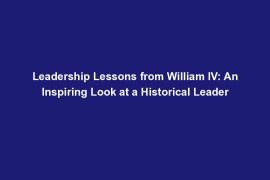Hey there, history buffs and aspiring leaders! Today, we’re diving into the fascinating world of Edward I of England and exploring the valuable leadership lessons we can learn from his reign.
Edward I, also known as Edward Longshanks, was a formidable monarch who ruled England from 1272 to 1307. His reign was marked by military conquests, administrative reforms, and a strategic vision that shaped the future of his kingdom. But what can a medieval king teach us about leadership in the modern world?
Studying historical figures like Edward I can provide us with valuable insights into effective leadership strategies and practices. By examining the successes and challenges faced by leaders of the past, we can uncover timeless lessons that are still relevant today.
In this blog post, we’ll be exploring two key leadership lessons that can be drawn from Edward I’s reign: strategic vision and resilience/adaptability. These lessons will help us understand how Edward I’s leadership style contributed to his success and how we can apply similar principles in our own leadership roles.
So, buckle up and get ready to embark on a journey through history as we uncover the leadership secrets of Edward I of England. Let’s dive in!
Leadership Lesson #1: Strategic Vision
Now, let’s delve into the first key leadership lesson we can learn from Edward I: strategic vision. Picture this – Edward I sitting in his throne room, mapping out his grand plans for expanding his kingdom and solidifying his legacy. He wasn’t just thinking about the here and now; he was thinking about the long-term future of his empire.
Edward I’s strategic vision was like a roadmap, guiding him towards his goals with purpose and foresight. He didn’t just react to situations as they arose; he proactively planned and strategized, positioning himself for success. By having a clear vision of where he wanted to go, Edward I was able to make decisions that ultimately led to the growth and stability of his kingdom.
So, what does this mean for us today? Well, it’s all about having a game plan. Like Edward I, modern-day leaders can benefit from having a strategic vision that guides their actions and decisions. Whether it’s in business, politics, or any other field, having a long-term perspective can help leaders navigate challenges, seize opportunities, and drive success.
Leadership Lesson #2: Resilience and Adaptability
Now, let’s shift our focus to another crucial leadership lesson we can glean from Edward I: resilience and adaptability. Think about the challenges Edward I faced during his reign – political intrigue, military threats, economic turmoil. Despite the odds stacked against him, he never backed down.
Edward I demonstrated resilience in the face of adversity, bouncing back from setbacks and staying steadfast in his pursuit of goals. He also showed remarkable adaptability, adjusting his strategies and tactics to overcome changing circumstances. In essence, Edward I was like a mighty oak tree, standing strong in the face of stormy weather.
So, what’s the takeaway for us? Well, it’s all about being flexible and resilient in the face of challenges. In today’s fast-paced and unpredictable world, leaders need to be able to roll with the punches, pivot when necessary, and bounce back from setbacks. By emulating Edward I’s resilience and adaptability, we can navigate through turbulent times and emerge stronger on the other side.
Stay tuned for the next section where we’ll explore more leadership lessons from the legendary Edward I!
Leadership Lesson #2: Resilience and Adaptability
Now, let’s dive into another crucial leadership lesson that we can learn from Edward I: resilience and adaptability. Throughout his reign, Edward I faced numerous challenges, both on the battlefield and in the political arena. However, what truly set him apart as a leader was his unwavering resilience in the face of adversity.
Challenges Faced
From rebellions in Wales and Scotland to financial crises and diplomatic tensions, Edward I encountered a myriad of obstacles during his rule. Yet, instead of being deterred by these challenges, he rose to the occasion with a sense of determination and resolve that inspired those around him.
Demonstrating Resilience
One of the most notable examples of Edward I’s resilience was his response to the Welsh uprising led by Llywelyn ap Gruffudd. Despite facing setbacks and losses on the battlefield, Edward I remained steadfast in his commitment to subduing the rebellion and ultimately emerged victorious through sheer perseverance and resilience.
Ability to Adapt
Moreover, Edward I showcased a remarkable ability to adapt to changing circumstances and navigate through complex political and military challenges. Whether it was reforming his administration, forging strategic alliances, or implementing innovative tactics on the battlefield, Edward I demonstrated a keen sense of adaptability that allowed him to overcome obstacles and achieve his objectives.
Modern-Day Applications
So, how can leaders today emulate Edward I’s resilience and adaptability in their own leadership roles? By staying agile in the face of adversity, learning from setbacks, and remaining flexible in their approach to problem-solving, leaders can navigate through turbulent times with grace and determination, just like Edward I did centuries ago.
Ultimately, Edward I’s legacy as a resilient and adaptable leader serves as a timeless reminder of the importance of perseverance and flexibility in the face of challenges. By drawing inspiration from his example, leaders today can chart a course towards success in their own endeavors, no matter how daunting the obstacles may seem.



